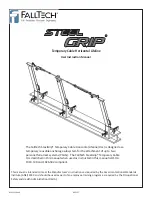
4.10
Releasing Lifeline Tension:
Upon completion of work, to move to a new location or to disconnect
from the end anchorage connectors, lifeline tension should
be released.
Step 1: Holding the cable side jaw of the turnbuckle to prevent the lifeline
from twisting, use a tool to rotate the turnbuckle. Rotate the
turnbuckle so that the jaws draw away from each other as shown in
Figure 28.
Step 2: Once enough tension has been removed from the lifeline, remove the
end attachment carabiners from their anchor points.
4.9
Connecting to the HLL System:
Approach the work area using the appropriate access equipment. Connect the PFAS connector (free end connector on the SAL or SRD) directly to
the HLL wire rope. Do not connect to any component other than the wire rope. Connectors must meet all compatibility and strength requirements.
Figure 28
Maintenance:
No scheduled maintenance is required, other than the replacement of items that failed inspection.
Service:
There are no specific service requirements for this system component.
Storage:
If the unit is removed from its installation location, it should be stored in a dry area free of corrosive elements that may harm
or cause the product not to function.
5.0 Maintenance, Service and Storage
6.0 Inspection
5.1
Pre-Use Inspection:
Prior to each the HLL system should be inspected by the user for damage, wear and to ensure the lifeline is properly
tensioned. Please review the inspection checklist for inspection requirements.
5.2
Inspection Frequency:
Other than pre-use inspection, the FallTech SteelGrip® Horizontal Lifeline should be inspected by a competent
person at least once a year.
5.3
Inspection Checklist:
A general inspection should be done at the intervals specified in this manual. Inspect as follows:
Step 1: Inspect labels. Ensure legibility of content. If labels are missing or illegible,
remove the system from service.
Step 2: Inspect all metal components for cracks, corrosion, deformities, missing or
noticable defects. Metal components include: the FallTech SteelGrip®Coil
Energy Absorber, optional tension indicator, turnbuckle, carabiner, thimble
eyes, shackles and all other hardware.
Step 3: Inspect the entire working length of wire rope for damage caused by
chemical corruption or excessive heat as evident by discoloration (A),
birdcaging (B), broken wire strands (C), kinks and bent strands (D), see
Figure 29.
Step 4: Inspect the SteelGrip®Coil Energy Absorber, it should not be extended, cracked or deformed. Figure 30 shows the coil energy absorber in
a non-deployed condition whereas Figure 31 shows the coil energy absorber in a partially deployed state. If there is tearing of the metal,
remove from service and replace.
Figure 30
Figure 31
Figure 29
MHLL12 Rev A
092117
13




































